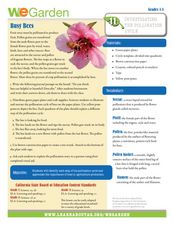Core Knowledge Foundation
Plants Tell It Again!™ Read-Aloud Anthology
A 190-page anthology explores the life and parts of plants, flowers, and trees while boosting reading comprehension skills. Literature and informational texts showcase Johnny Appleseed and George Washington Carver. Lessons...
Curated OER
Introduce Vocabulary: The Keeping Quilt
Students consider tier two vocabulary words. In this vocabulary lesson, students investigate the meaning of new vocabulary words found while reading The Keeping Quilt. Students record their new vocabulary words using a word journal or...
Curated OER
Plant Dissection
Students study plant parts and their functions in a dissection activity. In this plant dissection instructional activity, students use several handouts to help them learn parts of the plant and their functions. Students then dissect...
Curated OER
Bigger Flowers
Students discuss flowers and their parts, examine works by Georgia O'Keeffe, and draw, color, or paint large flowers.
Curated OER
Introduce Vocabulary: The Paperboy
Students discover the meaning of tier two vocabulary words. In this vocabulary lesson, students read The Paperboy, listening for 3 pre-selected, tier two vocabulary words. Words are defined by the teacher and students practice...
Curated OER
Plant Parts We Eat
I bet the kids in your class will love to eat their vegetables after an engaging lesson about edible plants. They read information about vegetables and edible plants, sort vocabulary words, identify plant parts, measure and graph the...
Curated OER
Body Language
First graders investigate the three main parts of a plant. In this plant parts lesson, 1st graders explore vocabulary for the topic and read a story about plant parts. Students view a PowerPoint and take a quiz for the topic....
Curated OER
Eat Your Plants
Students explore fruits and vegetables. In this fruits and vegetables instructional activity, students work in small groups investigating plant parts. Students discover that fruits and vegetables originate from different parts of plants.
Curated OER
Arthropod Mouth Parts and Food
Students identify the different types of mouths arthropods have for eating various types of food. Given photographs of the different types of arthropods, students identify which mouth they have and what type of food they can eat with...
Kentucky School for the Deaf
Levels of Organization within an Ecosystem
From tiny organisms to entire biomes, young scientists examine the interdependent relationships tying all living and non-living things together with this collection of ecology resources.
Curated OER
What Is A Plant?
Students explore plants. In this plant lesson, students examine organisms to determine which are plants. During this introductory lesson, students explore characteristics of living things.
Curated OER
Buzzy, Buzzy Bee
Students simulate honeybees pollinating flowers. In this pollination lesson, students role-play the process of pollination over the course of several seasons. Students graph results and share their graphs with the class.
Curated OER
Botany Basics
Middle schoolers survey plants. In this plant identification lesson, students explore the difference in plants to aid identification. Middle schoolers determine which plants may be used for medicinal reasons.
Curated OER
Busy Bees
Students explore the pollination cycle. For this pollination lesson, students investigate the process of pollination. Students illustrate the pollination cycle of bees on paper plates.
Curated OER
Weather / Seasons
Third graders hear and use the terms: el verano, la primavera, el invierno y el oto¿¿o. They review particular months in Spanish. Students explore the difference in connections between months and seasons in northern and southern...
Curated OER
Farm Products Help Me Grow
Students view a display of empty food containers (or illustrations). They select a food and decide as a class if it has an animal or plant origin. Students view a display of common farm animals that are commonly eaten (cow, pig, chicken,...















